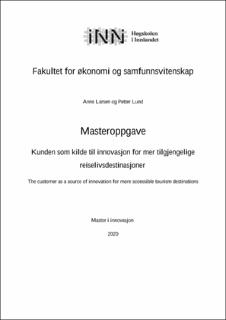| dc.contributor.author | Larsen, Anne | |
| dc.contributor.author | Lund, Petter | |
| dc.date.accessioned | 2020-10-16T08:06:17Z | |
| dc.date.available | 2020-10-16T08:06:17Z | |
| dc.date.issued | 2020 | |
| dc.identifier.uri | https://hdl.handle.net/11250/2683226 | |
| dc.description | Mastergradsoppgave i innovasjon | en_US |
| dc.description.abstract | Smarte destinasjoner har blitt et satsningsområde, og forskning på tilgjengelighet (accessibility) sammen med governance, innovasjon, bærekraft og teknologi er områder som forventes å få økt fokus i fremtiden. Innovasjon og tilgjengelighet kan være et konkurransefortrinn ved utviklingen av reiselivsdestinasjoner, der kunden gjerne velger en destinasjon som er bedre tilrettelagt enn andre destinasjoner.
Denne studien viser betydningen av å utvikle tjenester og opplevelser i nært samarbeid med kundene og hvordan de bør involveres i destinasjoners innovasjonsarbeid. Studien har tatt utgangspunkt i kvalitativ tilnærming, hvor vi valgte å gjennomføre en workshop der kundene blir involvert i en ideutviklingsfase. Det blir sett på hvordan reiselivsdestinasjoner bør tilpasse seg kunder med nedsatt funksjonsevne for å utvikle nye tjenester som kan bedre tilgjengeligheten.
Som det kommer frem av resultatene, vil effekten av å involvere kundene i en tidlig fase av innovasjonsprosessen kunne føre til bedre tilpassede produkter og tjenester. Studiens mest interessante funn indikerer at trygghet og tydelig informasjon gjennom hele brukerreisen er viktige nøkkelfaktorer. Man ser gjerne at funksjonsnedsatte som kundegruppe er lojale, og ofte vil bli faste kunder når de erfarer en god opplevelse. Resultatene indikerer også at det er fem ulike nøkkelfaktorer som bidrar til mer tilgjengelige reiselivsdestinasjoner, og disse er: bedre informasjon, smartere bestilling, tilpasset overnattingstilbud, tilpasset transporttilbud og tilpasset aktivitetstilbud. For at reiselivsnæringen skal kunne utvikle nye tjenester som er tilpasset mennesker med nedsatt funksjonsevne, er blant annet infrastruktur og informasjonsteknologi avgjørende for å skape mer bærekraftig utvikling og flere smarte og tilgjengelige reiselivsdestinasjoner. Dette støttes av funnene våre gjennom å se på brukerreisen til mennesker med nedsatt funksjonsevne og hvilke faktorer som bidrar til mer innovative og tilgjengelige destinasjoner. | en_US |
| dc.description.abstract | Abstract
Smart destinations have become a focus area and research on accessibility alongside governance, innovation, sustainability and technology are areas that are expected to receive increased attention in the future. Innovation and accessibility can be a competitive advantage in the development of tourism destinations, where the customer often chooses a destination that is better organized than other destinations.
This study shows the importance of developing services and experiences in close collaboration with customers and how they should be involved in the innovation work of destinations. The study is based on a qualitative approach, where we chose to conduct a workshop where customers become involved in an idea development phase. It examines how travel destinations should adapt to customers with disabilities in order to develop new services that can improve accessibility.
As the results show, the effect of involving customers at an early stage of the innovation process could lead to better customized products and services. The study's most interesting findings indicate that safety and comprehensive information throughout the user journey are important key factors. It is often seen that customers with disabilities are loyal and will become regular customers following a good experience. The results also indicate that especially five specific factors contribute to more accessible travel destinations, these being: better information, smarter bookings, customized accommodation, customized transport and customized activities. For the tourism industry to be able to develop new services that are adapted to people with disabilities, infrastructure and information technology, among other things, are crucial to creating more sustainable development and more smart and accessible tourism destinations. This is supported by our findings through looking at the user journey of people with disabilities and what factors contribute to more innovative and accessible destinations. | en_US |
| dc.language.iso | nob | en_US |
| dc.subject | Innovasjonsprosesser | en_US |
| dc.subject | Brukerinvolvering | en_US |
| dc.subject | Tilgjengelige reiselivsdestinasjoner | en_US |
| dc.subject | Opplevelsesbasert reiseliv | en_US |
| dc.subject | Innovation processes | en_US |
| dc.subject | User involvement | en_US |
| dc.subject | Accessible tourism | en_US |
| dc.subject | Experience-based tourism | en_US |
| dc.title | Kunden som kilde til innovasjon for mer tilgjengelige reiselivsdestinasjoner | en_US |
| dc.title.alternative | The customer as a source of innovation for more accessible tourism destinations | en_US |
| dc.type | Master thesis | en_US |
| dc.subject.nsi | VDP::Social science: 200 | en_US |
| dc.source.pagenumber | 82 | en_US |
